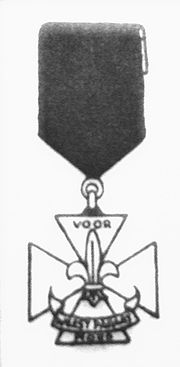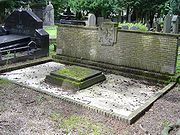
Jan van Hoof
Encyclopedia
Jan Jozef Lambert van Hoof (Nijmegen, 7 August 1922 - Nijmegen, 19 September 1944) was a member of the Dutch resistance
in World War II
, where he cooperated with Allied Forces
during Operation Market Garden
, and was executed in action. Before and during the war, Van Hoof was a Rover Scout, and the scouting medal the Nationale Padvindersraad
was named in his honour. He is credited with disabling German explosives placed to destroy a vital bridge to delay British liberation.
with the Katholieke Verkenners
(Catholic Scouts). But during World War II
Scouting
was forbidden in most occupied countries. All the Scouting organization were to be integrated into the Nationale Jeugdstorm (NJS), the Dutch version of the Hitler Youth
. However, the Dutch Scouting organisations did not agree with the terms of the NJS and as a result went underground or even joined the resistance.
Jan van Hoof in particular joined the resistance. Shortly after the start of the occupation of the Netherlands by the Nazis, he became member of a Rover crew and in the spring of 1943 he was secretly installed as full Rover Scout. During the occupation he made observations and drawings of his environment, especially the Waal Bridges. With the coming of the Allies
during Operation Market Garden in September 1944 he used his expertise by guiding the Allies through the city of Nijmegen.
It was said that he disarmed the explosives that were attached to the Waal Bridge during the fighting, though no-one saw him do it. After this heroic deed he went home and told his sister 'the bridge is saved'; then he returned to the American unit and resumed guiding them through the city.
Enquiries after the war could not positively identify Van Hoof as the individual who cut the wires to the bridge, however circumstancial evidence backs up the claim and when the Germans eventually tried to blow the bridge, just before its capture, their attempts failed.
The Dutch resistance members wore distinguishing clothing so they could be recognised as soldiers. The Germans however saw this as a provocation and did not recognize them as combatants but rather as traitors.
On the 19th of September, van Hoof was riding on the top of a Guards Armoured Division British Humber Scout Car
, guiding the vehicle from the allied column located at the central post office to the American soldiers and Guards Armoured Division tanks attacking the railway bridge, when Germans opened fire with a 2 cm gun on the vehicle, which caught fire. The British soldiers were already dead when the German troops arrived, but van Hoof was still alive. They took his gun, identity papers and his armband
which identified him officially an allied soldier. He was beaten and then shot through the head.
 Because of his deeds he was posthumously awarded:
Because of his deeds he was posthumously awarded:
After the war the Honor Medal for bravery of the Nationale Padvindersraad, the Dutch Boy Scouts umbrella organisation before 1973, was renamed to Jan van Hoof-kruis in his remembrance.
 These monuments and graves are dedicated to Jan van Hoof.
These monuments and graves are dedicated to Jan van Hoof.
(All Dutch)
Dutch resistance
Dutch resistance to the Nazi occupation of the Netherlands during World War II can be mainly characterized by its prominent non-violence, summitting in over 300,000 people in hiding in the autumn of 1944, tended to by some 60,000 to 200,000 illegal landlords and caretakers and tolerated knowingly...
in World War II
World War II
World War II, or the Second World War , was a global conflict lasting from 1939 to 1945, involving most of the world's nations—including all of the great powers—eventually forming two opposing military alliances: the Allies and the Axis...
, where he cooperated with Allied Forces
Allies of World War II
The Allies of World War II were the countries that opposed the Axis powers during the Second World War . Former Axis states contributing to the Allied victory are not considered Allied states...
during Operation Market Garden
Operation Market Garden
Operation Market Garden was an unsuccessful Allied military operation, fought in the Netherlands and Germany in the Second World War. It was the largest airborne operation up to that time....
, and was executed in action. Before and during the war, Van Hoof was a Rover Scout, and the scouting medal the Nationale Padvindersraad
Scouting Nederland
Scouting Nederland is the national Scout organisation of the Netherlands with approximately 110,000 members Scouting Nederland is the national Scout organisation of the Netherlands with approximately 110,000 members Scouting Nederland is the national Scout organisation of the Netherlands with...
was named in his honour. He is credited with disabling German explosives placed to destroy a vital bridge to delay British liberation.
Story of Jan van Hoof
Before the war he was a Boy ScoutBoy Scout
A Scout is a boy or a girl, usually 11 to 18 years of age, participating in the worldwide Scouting movement. Because of the large age and development span, many Scouting associations have split this age group into a junior and a senior section...
with the Katholieke Verkenners
Scouting Nederland
Scouting Nederland is the national Scout organisation of the Netherlands with approximately 110,000 members Scouting Nederland is the national Scout organisation of the Netherlands with approximately 110,000 members Scouting Nederland is the national Scout organisation of the Netherlands with...
(Catholic Scouts). But during World War II
World War II
World War II, or the Second World War , was a global conflict lasting from 1939 to 1945, involving most of the world's nations—including all of the great powers—eventually forming two opposing military alliances: the Allies and the Axis...
Scouting
Scouting
Scouting, also known as the Scout Movement, is a worldwide youth movement with the stated aim of supporting young people in their physical, mental and spiritual development, that they may play constructive roles in society....
was forbidden in most occupied countries. All the Scouting organization were to be integrated into the Nationale Jeugdstorm (NJS), the Dutch version of the Hitler Youth
Hitler Youth
The Hitler Youth was a paramilitary organization of the Nazi Party. It existed from 1922 to 1945. The HJ was the second oldest paramilitary Nazi group, founded one year after its adult counterpart, the Sturmabteilung...
. However, the Dutch Scouting organisations did not agree with the terms of the NJS and as a result went underground or even joined the resistance.
Jan van Hoof in particular joined the resistance. Shortly after the start of the occupation of the Netherlands by the Nazis, he became member of a Rover crew and in the spring of 1943 he was secretly installed as full Rover Scout. During the occupation he made observations and drawings of his environment, especially the Waal Bridges. With the coming of the Allies
Allies
In everyday English usage, allies are people, groups, or nations that have joined together in an association for mutual benefit or to achieve some common purpose, whether or not explicit agreement has been worked out between them...
during Operation Market Garden in September 1944 he used his expertise by guiding the Allies through the city of Nijmegen.
It was said that he disarmed the explosives that were attached to the Waal Bridge during the fighting, though no-one saw him do it. After this heroic deed he went home and told his sister 'the bridge is saved'; then he returned to the American unit and resumed guiding them through the city.
Enquiries after the war could not positively identify Van Hoof as the individual who cut the wires to the bridge, however circumstancial evidence backs up the claim and when the Germans eventually tried to blow the bridge, just before its capture, their attempts failed.
The Dutch resistance members wore distinguishing clothing so they could be recognised as soldiers. The Germans however saw this as a provocation and did not recognize them as combatants but rather as traitors.
On the 19th of September, van Hoof was riding on the top of a Guards Armoured Division British Humber Scout Car
Humber Scout Car
Humber Scout Car was a British light armoured car used in the Second World War.-History:Although at the outbreak of the Second World War the British Army already had the excellent Daimler Dingo, the need for scout cars could not be met by Daimler alone, so other companies were required to produce...
, guiding the vehicle from the allied column located at the central post office to the American soldiers and Guards Armoured Division tanks attacking the railway bridge, when Germans opened fire with a 2 cm gun on the vehicle, which caught fire. The British soldiers were already dead when the German troops arrived, but van Hoof was still alive. They took his gun, identity papers and his armband
Armband
An armband is a piece of material worn around the arm over the sleeve of other clothing if present. they may be worn for pure ornamentation to mark the wearer as belonging to group, having a certain rank or role, or being in a particular state or condition...
which identified him officially an allied soldier. He was beaten and then shot through the head.
Decorations

- 1945: The Medal for Freedom with bronze Palm (USA),
- 1946: Order of WilliamOrder of WilliamThe Military William Order, or often named Military Order of William , is the oldest and highest honour of the Kingdom of the Netherlands. The Order's motto is Voor Moed, Beleid en Trouw...
Knight 4th Class (Netherlands), - 1947: The King's Commendation for Brave ConductQueen's Commendation for Brave ConductInstituted in 1939 by King George VI as the King's Commendation for Brave Conduct, the Queen's Commendation for Brave Conduct acknowledged brave acts by civilians and members of the military in non-warlike circumstances during a time of war or in peacetime where the action would not otherwise be...
with silver laurel (UK),
After the war the Honor Medal for bravery of the Nationale Padvindersraad, the Dutch Boy Scouts umbrella organisation before 1973, was renamed to Jan van Hoof-kruis in his remembrance.
Monuments dedicated to Jan van Hoof

- Nijmegen, monument for Jan van Hoof
- Nijmegen, 'honour grave' of Jan van Hoof
- Nijmegen, monument on the Waal Bridge
- Nijmegen, monument at Lange Hezelstraat
- Nijmegen, Dutch War Cemetery
(All Dutch)
External links
- Left Handshake by Hilary Saint George SaundersHilary Saint George SaundersHilary Aidan Saint George Saunders was a British author. Saunders was born in Clifton, near Bristol. During World War I he served with the Welsh Guards....
, about Scouting during World War II - Jan van Hoof Article about Jan van Hoof, by Piet J. KroonenbergPiet J. KroonenbergPiet J. Kroonenberg is the historical consultant to the European Scout Committee. He has written books and articles about Scouting during World War II and post-War Scouting in Central and Eastern Europe.-Biography:...
(Dutch)

